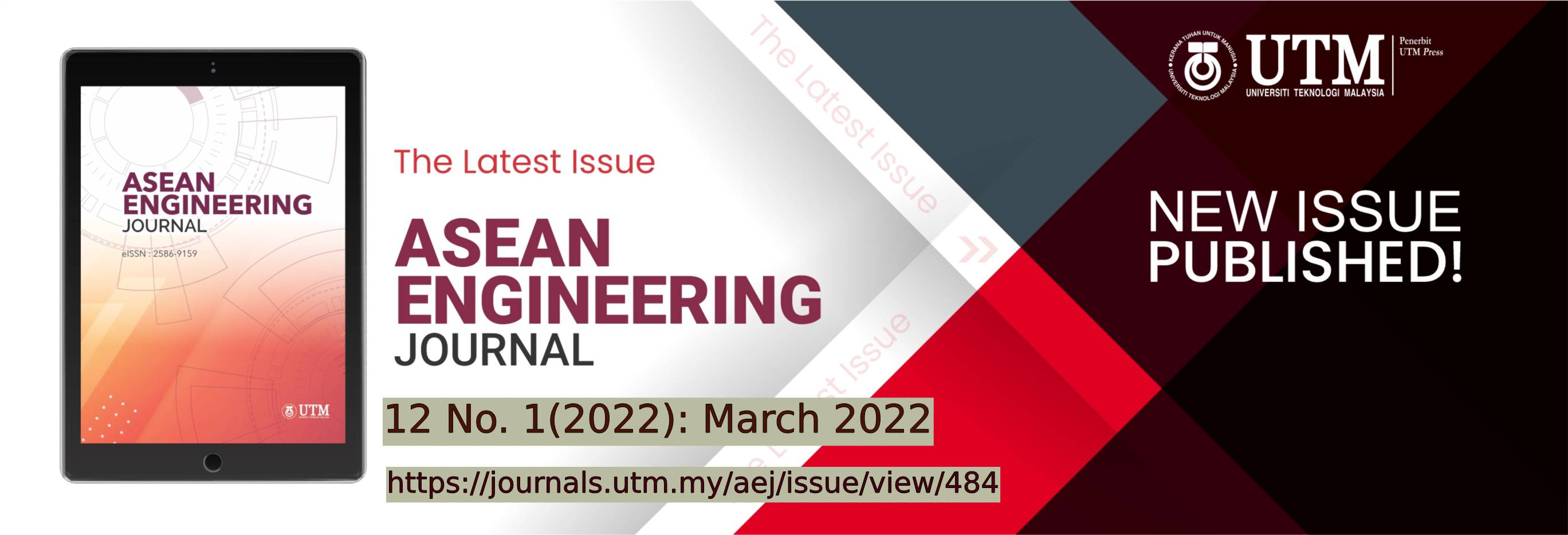HEIGHT RELIABILITY-BASED ANALYSIS OF WOVEN BAMBOO MAT REINFORCED MECHANICALLY STABILIZED EARTH WALL IN TEMPORARY RAILWAY EMBANKMENT
DOI:
https://doi.org/10.11113/aej.v12.17320Keywords:
Breakage, Local material, Mechanically stabilized earth wall, Reliability analysis, Woven bamboo matAbstract
Railway is a main transportation to sustain the fast-growing population and economy in many countries. Developing railway infrastructures, such as additional tracks, without disturbing daily operations often requires temporary mechanically stabilized earth as embankment construction. This paper discussed woven bamboo mat (WBM) as a highly potential local material that can be used in mechanically stabilized earth construction in such condition. Considering that WBM has a wide variation in tensile strength, this study determined the reliable railway embankment height through reliability-based analysis. First-order reliability method (FORM) was adopted to estimate the probability of failure (pF). The results of FORM were compared with the results of Monte Carlo simulation (MCS). The results showed positive trends in pF against increasing height, and the effective tensile capacity factor R negatively affected pF. The theoretically undegradable tensile strength in the design (R = 1.00) could increase the reliable height up to 12 m when sv = 0.2 m. Comparison between the FORM and MCS results showed that the pF calculated by FORM conformed with those computed by MCS. This study provided some insights and opened the opportunity for further research on other potential local materials as geomechanics reinforcement.
References
T.Y.D. Pamungkas, and I. Muthohar. 2017. “The issues of track maintenance management in Indonesia (based on study of the British railways),” Journal of the Civil Engineering Forum, 3(1): 51–60, doi: 10.22146/jcef.26573
A. Padilla-Rivera, B. Amor, and P. Blanchet. 2018. “Evaluating the link between low carbon reductions strategies and its performance in the context of climate change: a carbon footprint of a wood-frame residential building in Quebec, Canada,” Sustainability, 10: 1–20, doi: 10.3390/su10082715
B.V.V. Reddy, 2009. “Sustainable materials for low carbon buildings,” International Journal of Low-Carbon Technologies, 4(3): 175–81, doi: 10.1093/ijlct/ctp025
H.F. Archila-Santos, M.P Ansell, and P. Walker, 2012. “Low carbon construction using Guadua Bamboo in Colombia,” Key Engineering Materials, 517: 127–34, doi: 10.4028/www.scientific.net/KEM.517.127
E.Z. Escamilla, H.F. Archilla, D.A. Nuramo, and D. Trujillo, 2019. “Bamboo, an engineered alternative for buildings in the global south,” Bioclimatic Architecture in Warm Climate, 397-414, doi: 10.1007/978-3-030-12036-8_15
N.A. Sasmayaputra, 2017. Aplikasi anyaman bambu sebagai temporary reinforced soil retaining wall badan jalan kereta api: Application of Bamboo mat as a temporary reinforced soil retaining wall in a railway bed. Thesis (Master's), Universitas Gadjah Mada, Yogyakarta, Indonesia,
J.J.A. Janssen, 1995. Building with bamboo, Practical Action Publishing, United Kingdom,
K.S. Akhil, N. Sankar, and S. Chandrakaran, 2019. “Behaviour of model footing on bamboo mat-reinforced sand beds,” Soils and Foundation, 59(5): 1324–35, doi: 10.1016/j.sandf.2019.05.006
N.A. Sasmayaputra, A.D. Adi, and F. Faris, 2017 “Bamboo mat as a temporary reinforced soil retaining wall in a railway bed” In: Proceeding of the International Conference on Technology and Vocational Teacher (ICTVT 2017), Yogyakarta, Indonesia, 141.
J.T. Christian, C.C. Ladd, and G. Baecher, 1994 “Reliability and probability in stability analysis,” International Journal of Rock Mechanics and Mining Sciences & Geomechanic Abstracts, 120: 2180–207,. doi: 10.1016/0148-9062(93)91623-q
K.K. Phoon, 2017. “Role of reliability calculations in geotechnical design,” Georisk: Assessment and Management of Risk for Engineered System and Geohazards, 11(1): 4–21, doi: 10.1080/17499518.2016.1265653
M. Deng, 2015. Reliability-based optimization design of geosynthetic reinforced embankment slopes. Thesis (PhD). Missouri University of Science and Technology, Missouri, USA,
B.K. Low, and W.H. Tang, 1997. “Efficient reliability evaluation using spreadsheet,” Journal of Engineering Mechanics, 123(7): 749–52, doi: 10.1061/(ASCE)0733-9399(1997)123:7(749)
B.K. Low, and W.H. Tang, 2004. “Reliability analysis using object-oriented constrained optimization,” Structural Safety, 26(1): 69–89, doi: 10.1016/S0167-4730(03)00023-7
G.B. Baecher, and J.T. Christian, 2003. Reliability and Statistics in Geotechnical Engineering, John Wiley & Sons, New Jersey, USA,
J. Huang, and D.V. Griffiths, 2011. “Observations on FORM in a simple geomechanics example,” Structural Safety, 33(1): 115–9. doi: 10.1016/j.strusafe.2010.10.001
D.V. Griffiths, J. Huang, and G.A. Fenton, 2011. “Probabilistic infinite slope analysis,” Computers and Geotechnics, 38(4): 577–84, doi: 10.1016/j.compgeo.2011.03.006
V. Elias, B.R. Christopher, and R.R. Berg, 2000. Mechanically stabilized earth walls and reinforced soil slopes design and construction guidelines. FHWA-NHI-00-043, National Highway Institute, Federal Highway Administration, Department of Transportation, Washington D.C., USA,
R.M. Koerner, 2005. Designing with Geosynthetics, 5th Edition, Pearson Prentice Hall, New Jersey, USA,
S. Kaminski, A. Lawrence, D. Trujillo, and C. King, 2016. “Structural use of bamboo. Part 2: Durability and preservation,” The Structural Engineer, 94(10): 38–43,
Morisco, 1999.Rekayasa Bambu: Bamboo Engineering, Nafiri Offset, Yogyakarta, DIY, Indonesia,
K. Khalid, M.F. Ali, N.F.A. Rahman, and M.R. Mispan, 2016. “Application on
one-at-a-time sensitivity analysis of semi-distributed hydrological model in tropical watershed,” International Journal of Engineering and Technology, 8(2): 132-136, doi: 10.7763/IJET.2016.V8.872
A. Ang, and W. Tang, 2007.Probability Concepts in Engineering: Emphasis on Applications on Civil and Environmental Engineering, 2nd Edition, John Wiley & Sons, New Jersey, USA,
B. Hu, and Z. Luo, 2018. “Life-cycle reliability-based assessment of internal stability for mechanically stabilized earth walls in a heavy haul railway,” Computers and Geotechics, 101: 141–8, doi: 10.1016/j.compgeo.2018.04.023
















